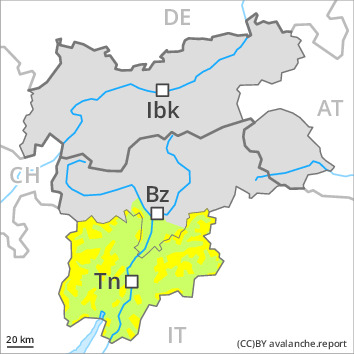
Danger level
 | treeline |
|  |
|  | ||||
|  |
|  |

Wind slabs and weakly bonded old snow are to be assessed with care and prudence.
The fresh and older wind slabs are prone to triggering in all aspects above the tree line. They are covered with new snow and therefore difficult to recognise.
Weak layers in the old snowpack can still be released in some places by individual winter sport participants. Such avalanche prone locations are to be found in particular on shady slopes above the tree line. At elevated altitudes the avalanche prone locations are to be found in all aspects. Whumpfing sounds and the formation of shooting cracks when stepping on the snowpack serve as an alarm indicating the danger. Mostly avalanches are rather small. In the regions neighbouring those that are subject to danger level 3 (considerable) the avalanche danger is a little higher.
Careful route selection is recommended.
Snowpack
dp.6: cold, loose snow and wind
dp.5: snowfall after a long period of cold
Over a wide area over a wide area 5 to 10 cm of snow will fall. In the south less snow will fall.
The new snow and wind slabs are lying on top of a weakly bonded old snowpack. Faceted weak layers exist in the centre of the snowpack, in particular on shady slopes above the tree line, as well as in all aspects at elevated altitudes. Whumpfing sounds and the formation of shooting cracks when stepping on the snowpack indicate the existence of a weak snowack. As a consequence of new snow and strong wind the wind slabs will increase in size additionally on Sunday. The barely recognisable wind slabs will become increasingly prone to triggering at elevated altitudes.
Tendency
As a consequence of falling temperatures the snowpack can not consolidate. The new snow and wind slabs remain prone to triggering, in particular at elevated altitudes. The avalanche danger will persist.

